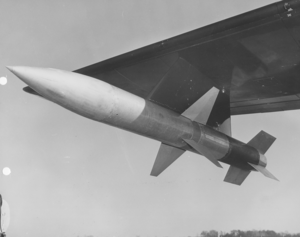| AAM-N-4 Oriole | |
|---|---|
 | |
| Type | Air-to-air missile |
| Place of origin | United States |
| Service history | |
| In service | 1950–1955 |
| Used by | United States Navy |
| Production history | |
| Designed | 1947 |
| Manufacturer | Martin |
| Specifications | |
| Mass | 1,500 pounds (680 kg) |
| Length | 11 feet 7 inches (3.53 m) |
| Diameter | 11 inches (280 mm) |
| Wingspan | 3 ft 2.8 in (0.986 m) |
| Warhead | High explosive |
| Warhead weight | 25 pounds (11 kg) |
| Operational range | 10 miles (16 km) |
| Flight altitude | Max at launch, 10 miles (16 km) |
| Maximum speed | Mach 2.5 |
| Guidance system | Active radar homing |
The AAM-N-4 Oriole was an early American air-to-air missile, developed by the Glenn L. Martin Company for the United States Navy. Designed for launch from carrier-based aircraft, the missile programme was cancelled before flight testing began, and the missiles produced were utilized as test vehicles.
Design and development
Development of the AAM-N-4 Oriole began in 1947, when a development contract was awarded by the United States Navy's Bureau of Ordnance to the Glenn L. Martin Company to develop a heavy air-to-air missile, utilizing active radar homing for fire and forget operation, for launch from aircraft operating from aircraft carriers. Oriole was intended to utilize a rocket or rocket-ramjet propulsion system; the intended range of the weapon was 20 miles (32 km), however as tested it was limited to a range of approximately 10 miles (16 km). Ready for launch, the missile weighed 1,500 pounds (680 kg), and used cruciform fins at the missile's midbody and at the tail for flight control. Flight speed was originally intended to be above Mach 3.
In 1948, the Oriole contract was redefined to be a guidance development program instead of a project to develop an operational missile; the program to construct test vehicles resumed in 1950 for research and development purposes, the missiles being redesignated RTV-N-16. Flight testing began shortly thereafter at the Naval Air Missile Test Center at Point Mugu, California; testing continued through 1953, with 56 flight tests being conducted throughout the program; as built the missile proved to be capable of Mach 2.5. The Oriole program was terminated at the end of 1953.
References
Citations
- Gunston 1979, p.221.
- Friedman 1982, p.150.
- ^ Parsch 2005
- Haley 1959, p.130.
- Peck 1950, p.264.
- Bowman 1957, p.169.
- ^ Hemsch 1992, p.17.
- "Aircraft Armament, Part 2: Missiles and Projectiles". Flight International, 28 January 1955, p.118.
- ^ USPMTC 1989, p.52-53
- Fahey 1958, p. 32.
Bibliography
- Bowman, Norman John (1957). The Handbook of Rockets and Guided Missiles. Chicago: Perastadion Press. ASIN B0007EC5N4.
- Fahey, James Charles (1958). The Ships and Aircraft of the U.S. Fleet (7th ed.). Washington, DC: Ships and Aircraft Publishers. ISBN 9780870216466.
- Friedman, Norman (1982). U.S. Naval Weapons: every gun, missile, mine, and torpedo used by the U.S. Navy from 1883 to the present day. Annapolis, MD: Naval Institute Press. ISBN 978-0-87021-735-7.
- Gunston, Bill (1979). The Illustrated Encyclopedia of the World's Rockets and Missiles. London: Salamander. ISBN 978-0861010295.
- Haley, Andrew Gallagher (1959). Rocketry and Space Exploration. Princeton, NJ: D. Van Nostrand Company. ASIN B000GB0580.
- Hemsch, Michael (1992). Tactical Missile Aerodynamics: General Topics. Progress in Astronautics and Aeronautics. Reston, VA: American Institute of Aeronautics and Astronautics. ISBN 978-1563470158.
- Nichols, Gina (2011). The Navy at Point Mugu. Charleston, SC: Arcadia Publishing. ISBN 978-0-7385-7532-2.
- Parsch, Andreas (2005). "Martin AAM-N-4 Oriole". Directory of U.S. Military Rockets and Missiles Appendix 1: Early Missiles and Drones. designation-systems.net. Retrieved 21 January 2013.
- Peck, James L.H. (January 1950). "How Fast Can We Fight?". Popular Mechanics. 94 (6). Chicago: Popular Mechanics Company. Retrieved 21 January 2013.
- United States Navy Pacific Missile Test Center (1989). Days of Challenge, Years of Change: a Technical History of the Pacific Missile Test Center. Washington, CC: Government Printing Office. ASIN B000S75AFK.
| United States Navy missile designations 1947–1962 | |||||||||
|---|---|---|---|---|---|---|---|---|---|
| Air-launched missiles |
| ||||||||
| Surface-launched missiles |
| ||||||||
| Test vehicles |
| ||||||||
Categories: